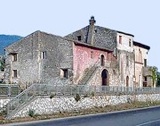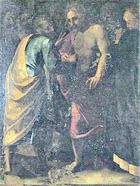


This structure is made up of a terrace of three buildings that have evolved over the centuries. The lower part of the central building is still recognisable as the original facade of the church of San Tommaso, which probably dates to the 12th century. The rear part of the building to the left is slightly older, and probably housed the adjacent hospice for lepers, which is documented from the early 13th century.
The function of the hospice was changed from the care of lepers to the care of the poor and infirmed in 1558.
The complex subsequently passed to the Valenti family. Cardinal Erminio Valenti commissioned the restoration of the church in 1609. The inscription that Filippo Valenti, Abbot of San Tommaso erected to the right of the portal of the church suggests that it had become very important by the 18th century:
-
✴The future King Charles III of Spain stayed here in 1734 on his way to Rome for his coronation as King of Naples and Sicily.
-
✴Pope Pius VI stayed here in 1782 on his return to Rome from Vienna, to receive the homage of the religious and civic authorities of Trevi. (He must have been impressed because he returned Trevi to city status two years later).
After the unification of Italy in 1860, the ownership of San Tommaso passed to the Congregazione di Carità and the complex was largely rebuilt as a farmhouse. (Although it is now hemmed in by industrial buildings and by the busy main road, it originally enjoyed a rural setting).
Art from the Church
Incredulity of St Thomas (ca. 1609)


